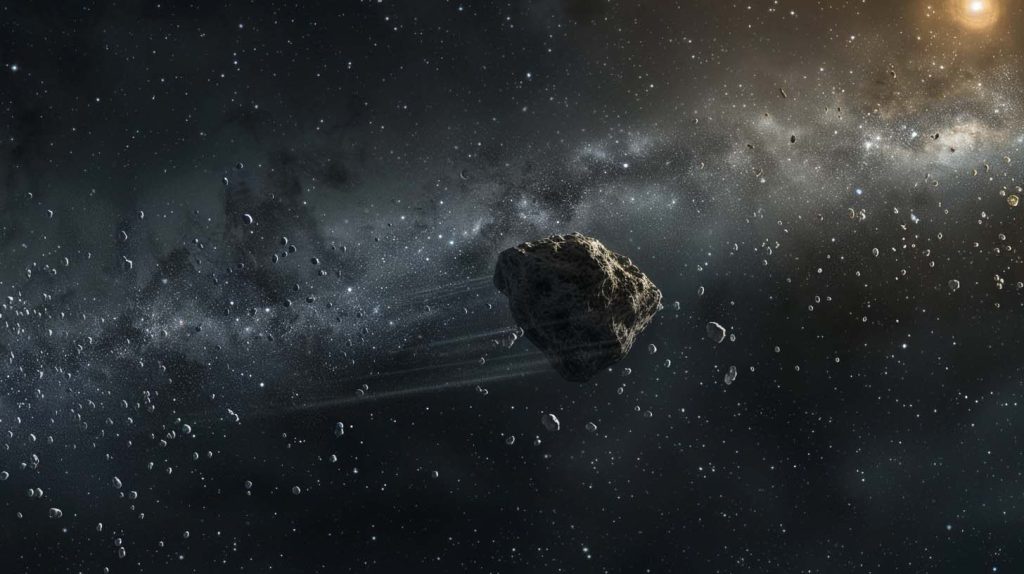The darkness of space surrounding Earth swirls with a swarm of tiny, icy objects expelled from the far reaches of our solar system. Neither comets nor asteroids, these mysterious objects may be one way water got to Earth billions of years ago.
A new study has found that up to 60% of near-Earth objects are dark comets. Dark comets are nearly invisible hybrid objects that act as both comets and asteroids. These dark comets may have been part of a much larger object in the solar system’s asteroid belt, between Mars and Jupiter, that was then ejected and broken up into smaller pieces that are now approaching Earth. Investigation result It is published on the preprint server arxiv. Icarus journal
“We don’t know if these dark comets delivered water to Earth; we can’t say that. But we can say that how Earth’s water got here is still up for debate,” said Aster Taylor, an astronomy graduate student at the University of Michigan and lead author of the new study. statement“Our work shows that this is another pathway that could deliver ice to the Earth environment from elsewhere in the solar system.”
Approximately 71% of the Earth is covered by water, making it a key ingredient for life on Earth. Despite water’s vitality to Earth, scientists still don’t know how it got to Earth. There are many theories about how Earth got its water. Earth may have been born with water in it, or water may have arrived on Earth via rocks moving through space, such as asteroids or comets.
Asteroids are rocky bodies that orbit the Sun in the rings between Mars and Jupiter, close enough to the Sun that their ice turns to gas. Comets, on the other hand, are made of ice and dust. As a comet gets closer to the Sun, its material begins to evaporate, forming a fuzzy tail called a coma.
Somewhere in between are dark comets. Dark comets are small, nearly invisible objects that lack cometary tails, but their orbits aren’t determined by the Sun’s gravity like asteroids are. Instead, the seven dark comets examined by the researchers in the new study exhibited orbital acceleration that couldn’t be explained by the Sun’s gravity alone. But comets exhibit this erratic motion, and their orbits accelerate when they heat up and their ice sublimates.
“These objects are thought to come from the inner and/or outer main asteroid belt, suggesting this is another mechanism for introducing ice into the inner solar system,” Taylor said.
To pinpoint the origins of dark comets, the researchers created models that simulated the non-gravitational acceleration of various objects and traced the paths these objects would take over a period of 100,000 years. They found that the main asteroid belt is the most likely source of objects experiencing non-gravitational acceleration, and that most of these objects end up in the areas where dark comets are found today.
One of the objects examined in the new study, the dark comet 2003 RM, is on an elliptical orbit that took it close to Earth, then toward Jupiter, then past Earth again, suggesting that the comet was likely pushed inward from a distant orbit around the gas giant.
Dark comets are just pieces of larger asteroids that survived a cosmic impact, but they likely still contain ice, which is why they’re spinning faster and faster. “These pieces have ice on them, so they spin faster and faster and break up into more pieces. To get these small, fast-spinning objects, you need a few larger objects to break up into pieces,” Taylor says.
This new study only just scratches the surface about these shadowy objects; there’s still a lot to learn, including how dark comets may have contributed to Earth’s origin story. “There may be more ice in the inner main belt than we thought, and there may be other objects like this out there,” Taylor said. “This could be a significant portion of the closest population. We don’t really know, but this discovery opens up a lot more questions.”
more: Beyond the Planets: Strange Underdogs of the Solar System


